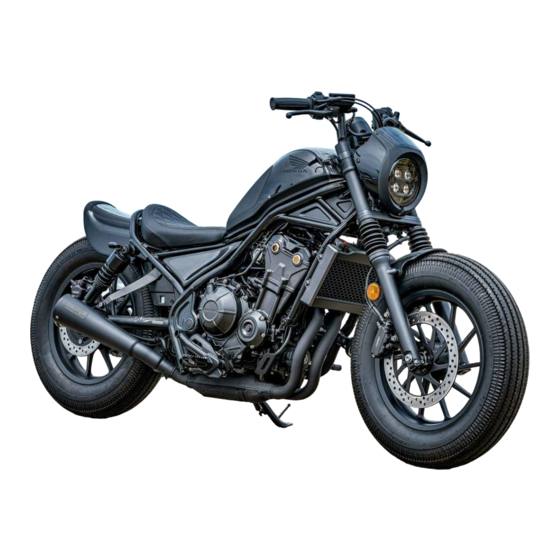
Table of Contents
Advertisement
Advertisement
Chapters
Table of Contents

Summarization of Contents
Vehicle Safety
Safety Guidelines
Essential safety rules and riding recommendations for rider well-being.
Safety Labels
Identifies and explains important safety and warning labels on the vehicle.
Safety Precautions
Critical precautions for safe riding, including protective gear and rider conduct.
Riding Precautions
Guidelines for safe operation, covering break-in, braking, and environmental conditions.
Accessories & Modifications
Advice on using approved accessories and warnings against unsafe modifications.
Loading
Rules and cautions for carrying passengers and cargo safely on the vehicle.
Operation Guide
Parts Location
Visual guide to identify the location of key motorcycle components and parts.
Instruments
Detailed explanation of the instrument panel, displays, and their functions.
Indicators
Explanation of dashboard indicators, warning lights, and their meanings.
Switches and Controls
Description and operation of the motorcycle's various switches and controls.
Starting the Engine
Step-by-step procedure for safely starting the vehicle's engine.
Shifting Gears
Recommended shift points and guidance for proper gear operation.
Refueling
Procedures and essential guidelines for safely refueling the vehicle.
Storage Equipment
Details on the location and use of onboard tools and storage compartments.
Maintenance
Importance of Maintenance
Explains why regular maintenance is crucial for vehicle longevity and rider safety.
Maintenance Schedule
Outlines recommended service intervals and tasks for optimal vehicle performance.
Maintenance Record
A log to track and record all completed maintenance services for the vehicle.
Maintenance Fundamentals
Covers essential principles and basic procedures for performing vehicle maintenance.
Replacing Parts
Guidelines for using genuine parts and their importance for reliability and safety.
Battery
Information on battery maintenance, charging procedures, and terminal cleaning.
Fuses
How to locate, inspect, and replace fuses to maintain electrical systems.
Engine Oil
Guidance on checking, adding, and selecting the correct engine oil for the vehicle.
Coolant
Procedures for checking and adding coolant to the engine's cooling system.
Brakes
Instructions for checking brake fluid levels and brake pad wear indicators.
Side Stand
Checking the proper function and operation of the vehicle's side stand.
Drive Chain
Steps for inspecting, cleaning, and lubricating the motorcycle's drive chain.
Clutch
Instructions for checking and adjusting the clutch lever freeplay for proper engagement.
Throttle
Procedures for checking and adjusting the throttle grip freeplay for smooth operation.
Other Adjustments
Guidance on adjusting the rear suspension spring preload for ride comfort and handling.
Troubleshooting
Engine Will Not Start
Diagnostic steps to resolve issues when the engine fails to start.
Overheating
Procedures to follow if the high coolant temperature indicator is activated.
Warning Indicators On or Flashing
Troubleshooting low oil pressure and PGM-FI malfunction indicator lamps.
ABS Indicator Issues
How to diagnose and address issues indicated by the ABS system warning light.
Tire Puncture
Emergency repair methods for tire punctures and when to seek professional service.
Electrical Trouble
Guidance on resolving electrical issues like a dead battery or faulty bulbs.
Blown Fuse
Instructions for locating, inspecting, and replacing fuses in the vehicle's electrical system.
Information
Keys
Information on ignition and steering lock keys, including obtaining duplicates.
Instruments, Controls, & Other Features
Details on ignition switch, engine stop switch, and other vehicle features.
Caring for Your Vehicle
Essential guidelines for washing, polishing, and maintaining the vehicle's appearance.
Storing Your Vehicle
Recommendations and procedures for properly storing the vehicle for extended periods.
Transporting Your Vehicle
Safe methods and precautions for transporting the motorcycle.
You & the Environment
Tips for environmentally responsible vehicle ownership and maintenance practices.
Vehicle Identification Number
Location of VIN and engine serial numbers, crucial for registration and parts ordering.
Emission Control Systems
Explains exhaust, noise, and evaporative emission systems and their requirements.
Catalytic Converter
Details on protecting the catalytic converter and its role in reducing emissions.
Authorized Manuals
Information on how to obtain service and owner's manuals for the vehicle.
Warranty Coverage and Service
Overview of vehicle warranties and procedures for obtaining service.
Honda Contacts
Contact details for Honda customer relations in the USA and Canada.
Reporting Safety Defects
How to report potential safety defects to relevant government agencies.
Specifications
Main Components
Key physical dimensions, weight, and performance specifications of the vehicle.
Service Data
Technical maintenance data, including tire sizes, fluid capacities, and spark plug specifications.
Bulbs
Specifications for the type of bulbs used in the vehicle's lighting system.
Fuses
Specifications for the main fuse and other fuses used in the vehicle's electrical system.










Need help?
Do you have a question about the CMX500 2022 and is the answer not in the manual?
Questions and answers